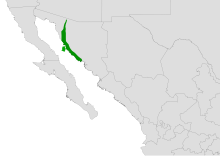| Echinocereus scopulorum | |
|---|---|

| |
|
Scientific classification
| |
| Kingdom: | Plantae |
| Clade: | Tracheophytes |
| Clade: | Angiosperms |
| Clade: | Eudicots |
| Order: | Caryophyllales |
| Family: | Cactaceae |
| Subfamily: | Cactoideae |
| Genus: | Echinocereus |
| Species: | E. scopulorum
|
| Binomial name | |
| Echinocereus scopulorum Britton & Rose 1922
| |

| |
Echinocereus scopulorum is a species of cactus native to Mexico. [2]
Description
Echinocereus scopulorum grows as a solitary cactus with cylindrical shoots ranging from 10 to 40 cm (3.9 to 15.7 in) long and up to 10 cm (3.9 in) in diameter, concealed by spines. [3] It has 13 to 15 ribs, with three to ten central spines shorter than the approximately 20 peripheral spines, which are whitish with darker tips and 0.4 to 1.4 cm (0.16 to 0.55 in) long. [3]
The fragrant, funnel-shaped flowers are light pink to magenta with a white throat, appearing near the tips of the shoots. [3] They are 7 to 8.5 cm (2.8 to 3.3 in) centimeters long and up to 10 cm (3.9 in) in diameter. [3] The spherical to egg-shaped fruits are dark green with white pulp, dry when ripe, but do not crack open. [3]
Distribution
Echinocereus scopulorum is found along the coastal xeric scrublands of the Mexican state of Sonora, on Isla Tiburón, and in the states of Sinaloa and Nayarit.[ citation needed] It lives in the Sonoran desert, on rocky soils at elevations of 5 to 800 m (16 to 2,625 ft). [1] [4]
Taxonomy
First described by Nathaniel Lord Britton and Joseph Nelson Rose in 1922 in The Cactaceae, the species name scopulorum, meaning 'mountain peak', 'cliff', or 'rock' in Latin, refers to its preferred habitat. [5]
References
- ^ a b Felger, R.S. (2017) [amended version of 2013 assessment]. "Echinocereus scopulorum". IUCN Red List of Threatened Species. 2017: e.T151792A121443422. doi: 10.2305/IUCN.UK.2017-3.RLTS.T151792A121443422.en.
- ^ "Echinocereus scopulorum Britton & Rose". Plants of the World Online. Royal Botanic Gardens, Kew. Retrieved 2024-06-29.
- ^ a b c d e Anderson, Edward F.; Eggli, Urs (2005). Das grosse Kakteen-Lexikon (in German). Stuttgart (Hohenheim): Ulmer. p. 209. ISBN 3-8001-4573-1.
-
^
"Echinocereus scopulorum". LLIFLE. 2013-08-04. Retrieved 2024-06-30.
 This article incorporates text from this source, which is available under the
CC BY-SA 3.0 license.
This article incorporates text from this source, which is available under the
CC BY-SA 3.0 license.
- ^ Britton, Nathaniel Lord; Eaton, Mary E.; Rose, J. N.; Wood, Helen Adelaide (1919). The Cactaceae : descriptions and illustrations of plants of the cactus family. Washington: Carnegie Institution of Washington. doi: 10.5962/bhl.title.46288.
External links
-
 Media related to
Echinocereus scopulorum at Wikimedia Commons
Media related to
Echinocereus scopulorum at Wikimedia Commons -
 Data related to
Echinocereus scopulorum at Wikispecies
Data related to
Echinocereus scopulorum at Wikispecies
| Echinocereus scopulorum | |
|---|---|

| |
|
Scientific classification
| |
| Kingdom: | Plantae |
| Clade: | Tracheophytes |
| Clade: | Angiosperms |
| Clade: | Eudicots |
| Order: | Caryophyllales |
| Family: | Cactaceae |
| Subfamily: | Cactoideae |
| Genus: | Echinocereus |
| Species: | E. scopulorum
|
| Binomial name | |
| Echinocereus scopulorum Britton & Rose 1922
| |

| |
Echinocereus scopulorum is a species of cactus native to Mexico. [2]
Description
Echinocereus scopulorum grows as a solitary cactus with cylindrical shoots ranging from 10 to 40 cm (3.9 to 15.7 in) long and up to 10 cm (3.9 in) in diameter, concealed by spines. [3] It has 13 to 15 ribs, with three to ten central spines shorter than the approximately 20 peripheral spines, which are whitish with darker tips and 0.4 to 1.4 cm (0.16 to 0.55 in) long. [3]
The fragrant, funnel-shaped flowers are light pink to magenta with a white throat, appearing near the tips of the shoots. [3] They are 7 to 8.5 cm (2.8 to 3.3 in) centimeters long and up to 10 cm (3.9 in) in diameter. [3] The spherical to egg-shaped fruits are dark green with white pulp, dry when ripe, but do not crack open. [3]
Distribution
Echinocereus scopulorum is found along the coastal xeric scrublands of the Mexican state of Sonora, on Isla Tiburón, and in the states of Sinaloa and Nayarit.[ citation needed] It lives in the Sonoran desert, on rocky soils at elevations of 5 to 800 m (16 to 2,625 ft). [1] [4]
Taxonomy
First described by Nathaniel Lord Britton and Joseph Nelson Rose in 1922 in The Cactaceae, the species name scopulorum, meaning 'mountain peak', 'cliff', or 'rock' in Latin, refers to its preferred habitat. [5]
References
- ^ a b Felger, R.S. (2017) [amended version of 2013 assessment]. "Echinocereus scopulorum". IUCN Red List of Threatened Species. 2017: e.T151792A121443422. doi: 10.2305/IUCN.UK.2017-3.RLTS.T151792A121443422.en.
- ^ "Echinocereus scopulorum Britton & Rose". Plants of the World Online. Royal Botanic Gardens, Kew. Retrieved 2024-06-29.
- ^ a b c d e Anderson, Edward F.; Eggli, Urs (2005). Das grosse Kakteen-Lexikon (in German). Stuttgart (Hohenheim): Ulmer. p. 209. ISBN 3-8001-4573-1.
-
^
"Echinocereus scopulorum". LLIFLE. 2013-08-04. Retrieved 2024-06-30.
 This article incorporates text from this source, which is available under the
CC BY-SA 3.0 license.
This article incorporates text from this source, which is available under the
CC BY-SA 3.0 license.
- ^ Britton, Nathaniel Lord; Eaton, Mary E.; Rose, J. N.; Wood, Helen Adelaide (1919). The Cactaceae : descriptions and illustrations of plants of the cactus family. Washington: Carnegie Institution of Washington. doi: 10.5962/bhl.title.46288.
External links
-
 Media related to
Echinocereus scopulorum at Wikimedia Commons
Media related to
Echinocereus scopulorum at Wikimedia Commons -
 Data related to
Echinocereus scopulorum at Wikispecies
Data related to
Echinocereus scopulorum at Wikispecies
